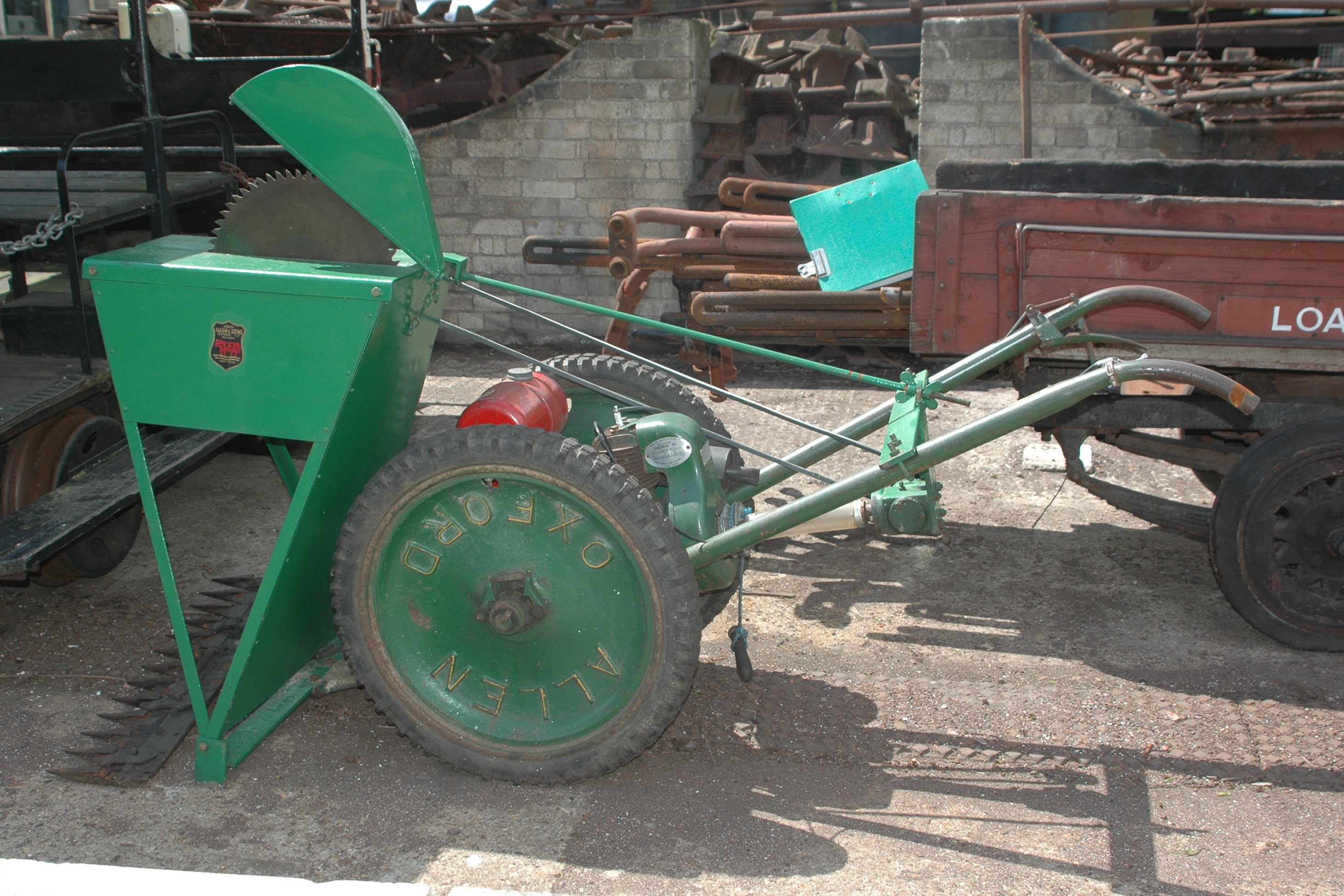Allen Scythe on:
[Wikipedia]
[Google]
[Amazon]
 The Allen Scythe, sometimes called the Allen Power Scythe, is a petrol-powered finger-bar mower. It was made from 1933 until 1973 by
The Allen Scythe, sometimes called the Allen Power Scythe, is a petrol-powered finger-bar mower. It was made from 1933 until 1973 by
Episode 6 Wartime Farm "...use some clever 1940s technology..."
at bbc.co.uk Accessed 3 March 2018
from The Old Lawnmower Club
Engine Settings
from The Old Lawnmower Club {{Portal bar, Agriculture, Food, Technology Agricultural machinery Two-stroke engine technology
John Allen and Sons
John is a common English name and surname:
* John (given name)
* John (surname)
John may also refer to:
New Testament
Works
* Gospel of John, a title often shortened to John
* First Epistle of John, often shortened to 1 John
* Second ...
in Cowley, Oxfordshire
Cowley () is a residential and industrial area in Oxford, in the county of Oxfordshire, England. Cowley's neighbours are Rose Hill and Blackbird Leys to the south, Headington to the north and the villages of Horspath and Garsington across f ...
. The company, formerly the Eddison and Nodding Company, was bought in 1897 by John Allen, who renamed it the Oxford Steam Plough Company, and then renamed it to John Allen and Sons.
Description
The Allen Scythe does not resemble a hand scythe but serves the same purpose. The engine drives a or or 4ft wide toothed blade sliding back and forth horizontally across stationary teeth to produce a scissor action, and also drives two large wheels for forward travel. There are handles to allow the machine to be controlled by an operator walking behind it, controls comprise throttle and clutch. The wheels are driven through ratchets which allow either wheel to free-wheel when steering the machine (the wheel on the outside of the turn will be able to rotate faster than the inside wheel). This system is simpler than a differential axle and, unlike a differential, means that when one wheel slips the other keeps turning and driving the machine forwards. It has the disadvantage that the machine can run away from the operator downhill and for this reason the ratchet mechanisms can be locked. The machines are extremely robust and many from the 1950s are still in regular use. They can be dangerous, as the clutch system only disengages the wheel drive from the engine: the blades cut all the time the engine runs. Later models were available with different attachments, including rotating brushes that replaced the cutting head, air or water pumps and saws or hedge trimmers that drove from the starting pulley side of the engine.Engine
John Allen and Sons used a number of engine types, the most common being a Villierstwo-stroke
A two-stroke (or two-stroke cycle) engine is a type of internal combustion engine that completes a power cycle with two strokes of the piston, one up and one down, in one revolution of the crankshaft in contrast to a four-stroke engine which re ...
with magneto ignition
An ignition magneto (also called a high-tension magneto) is an older type of ignition system used in spark-ignition engines (such as petrol engines). It uses a magneto and a transformer to make pulses of high voltage for the spark plugs. The old ...
and rope start. The engines may fail to start because of ignition problems. The spark should occur when the piston is 3/16 of an inch before top dead centre
In a reciprocating engine, the dead centre is the position of a piston in which it is either furthest from, or nearest to, the crankshaft. The former is known as top dead centre (TDC) while the latter is known as bottom dead centre (BDC).
...
(TDC) on all Villiers engines except for the Villiers Mk. 11C & 25C which should spark 5/32 of an inch before TDC.
Popular culture
Episode 6 of theBBC Two
BBC Two is a British free-to-air Public service broadcasting in the United Kingdom, public broadcast television channel owned and operated by the BBC. It is the corporation's second flagship channel, and it covers a wide range of subject matte ...
reality television
Reality television is a genre of television programming that documents purportedly unscripted real-life situations, often starring ordinary people rather than professional actors. Reality television emerged as a distinct genre in the early 1990s ...
series '' Wartime Farm'' featured an Allen Scythe. Cast members Alex Langlands and Peter Ginn
Peter Ginn is a British archaeologist, best known as a presenter of the BBC educational television documentary series (2005–2014) known as the BBC historic farm series. Ginn and Ruth Goodman were the only presenters to appear in every ''Farm ...
used it to harvest hay in a churchyard.at bbc.co.uk Accessed 3 March 2018
References
Further reading
* *Patterson, Stevan D.T. (2021). The Allen Motor Scythe, self published.External links
from The Old Lawnmower Club
Engine Settings
from The Old Lawnmower Club {{Portal bar, Agriculture, Food, Technology Agricultural machinery Two-stroke engine technology